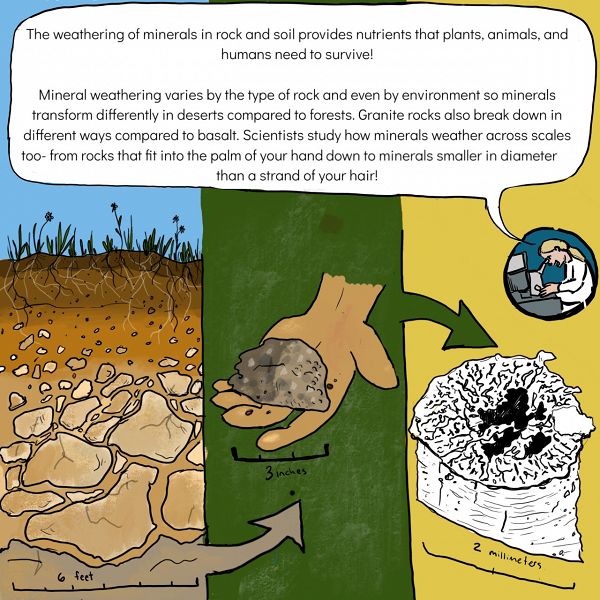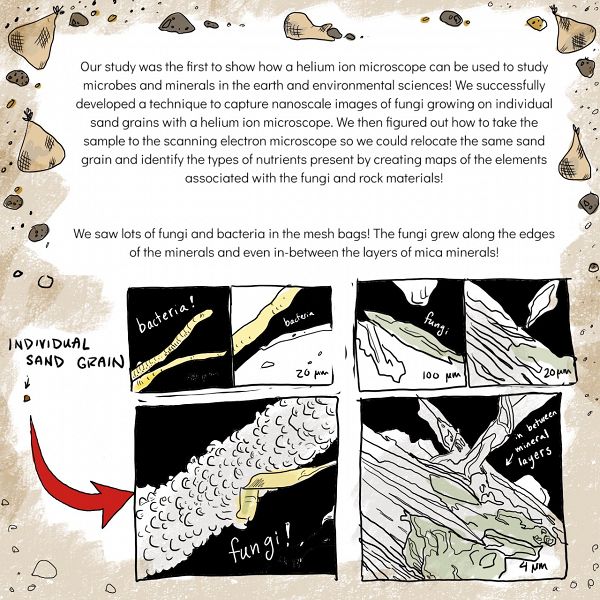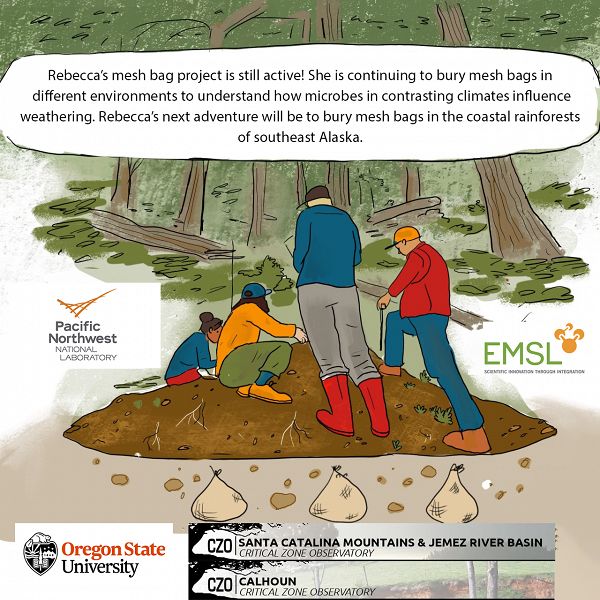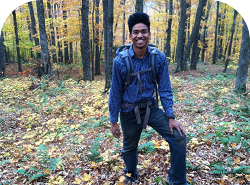May 21, 2020
An illustrated introduction to Dr. Rebecca Lybrand's research on digging up microbes in the Critical Zone.
By Drs. Rebecca Lybrand (Oregon State University) and Justin Richardson (UMass Amherst)
Illustrated by Alana McGillis
Panel 1. Dr. Rebecca Lybrand stands on a rocky, forested hillslope, waves and says, “I am Dr. Rebecca Lybrand, and I study how plants, microbes, and minerals interact to form soil in the Critical Zone!”
Rebecca explains that the weathering or breaking down of minerals in rock and soil provides nutrients that plants, animals, and humans need to survive. Scientists study how minerals, which are different depending on rock type, weather across scales from in the ground to under a microscope.
Microorganisms living in the soil are known as microbes, and like fungi and bacteria, enhance the weathering of minerals by releasing nutrients from the minerals to be taken up by plants. How microbes contribute to the process of mineral weathering, especially at the microscopic scale, is not fully understood.
To study this, Rebecca and her team sealed different rock types (i.e. basalt, granite and quartz) with different minerals into mesh bags and buried the bags in water-limited desert and forest sites in Arizona and a humid forest in South Carolina.
After 1 year, they retrieved the minerals from the soil and traveled to the Pacific Northwest National Laboratory (PNNL) to study how fungi grew into the mesh bags and interacted with the minerals. At the Environmental Molecular Sciences Laboratory at PNNL, both a scanning electron and helium ion microscope were used to see how individual grains were changed by fungi and water moving through the mesh bags.
By using these microscopes, the team developed a technique to capture nanoscale images of fungi growing on individual sand grains and identify the types of nutrients present. Lots of fungi were present in the mesh bags, growing along edges and in-between layers of minerals.
Rebecca’s mesh bag project is still active as a team is shown burying more bags in different environments. Her next adventure is to bury bags in coastal rainforests of southeast Alaska.

Rebecca Lybrand
CZO COLLABORATOR. Former grad student at Catalina-Jemez CZO. Specialty: Geochemistry and Soil Sciences
All Disciplines Geochemistry / Mineralogy Biology / Molecular PEOPLE
COMMENT ON "Adventures in the Critical Zone"
All comments are moderated. If you want to comment without logging in, select either the "Start/Join the discussion" box or a "Reply" link, then "Name", and finally, "I'd rather post as a guest" checkbox.
ABOUT THIS BLOG
Justin Richardson and his guests answer questions about the Critical Zone, synthesize CZ research, and meet folks working at the CZ observatories
General Disclaimer: Any opinions, findings, conclusions or recommendations presented in the above blog post are only those of the blog author and do not necessarily reflect the views of the U.S. CZO National Program or the National Science Foundation. For official information about NSF, visit www.nsf.gov.
Explore Further









